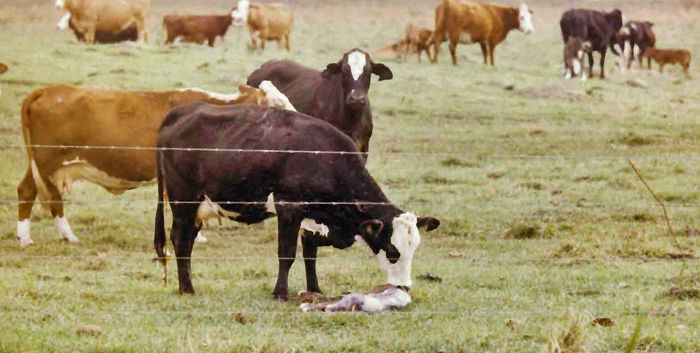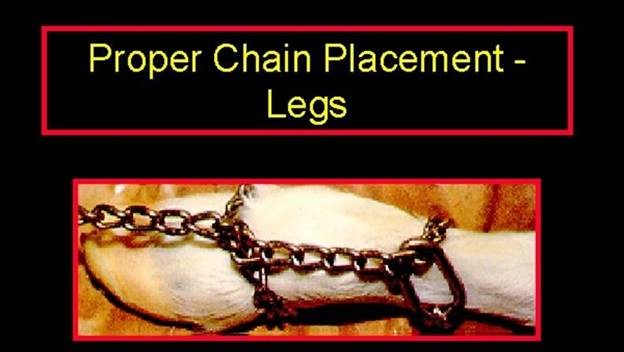
It is imperative that the newborn calf begins to breathe on its own as soon as possible. Credit: Doug Mayo
Glenn Selk, Oklahoma State University Emeritus Extension Animal Scientist
Prepare before you pull (that difficult birth)
Before applying the obstetrical (OB) chains to “pull” a calf during a difficult birth, a proper analysis of the situation must be made. Wash the vulva, anus and the area in between using soap and warm water. Pulling on a calf should only be done when the presentation and posture of the calf are normal. Normal is defined as the “anterior presentation” with fore feet first, head resting on the limbs, and the eyes level with the knees. A backwards calf can be delivered only when both back limbs are presented. Before chains are applied, be certain that the cervix is completely dilated.
To properly use obstetrical chains when assisting with a difficult birth, follow the this procedure. To attach the chain, loop it around the thin part of the legs above the fetlocks. Then, make a half hitch and tighten it below the joint and above the feet on both legs. (See photo below). Make certain that the chain is positioned in such a manner that is goes over the top of the toes. In this way the pressure is applied so as to pull the sharp points of the calves hooves away from the soft tissue of the vaginal wall. (The toes of the backwards calf will be upside-down compared to the forward presentation).
Helping the newborn calf breathe
Despite our best efforts at bull selection and heifer development, cows or heifers occasionally need assistance at calving time. Every baby calf has a certain degree of respiratory acidosis. Acidosis is the result of the deprivation of oxygen and the accumulation of carbon dioxide that results from the passage of the calf through the birth canal. The excess of carbon dioxide results in a build-up of lactic acid (therefore the acidosis.) In order to correct the lack of oxygen and the excess of carbon dioxide and its by-products, the healthy calf will pant vigorously shortly after birth. Some calves, however, may be sluggish and slow to begin this corrective process.
It is imperative that the newborn calf begins to breathe as soon as possible. To stimulate the initiation of the respiratory process, a few ideas may help. First, manually clear the mouth and nasal passages of fluids and mucus. Traditionally, compromised calves were held up by their hind legs to allow fluid to drain from the airways, but now many veterinarians and animal scientists don’t recommend this. Most of the fluid that drains from an upside-down calf is stomach fluid, important to health. Holding the calf by its hind legs also puts pressure on the diaphragm from abdominal organs, interfering with normal breathing. It’s better to use a suction bulb to clear the airways.
[warning]Hanging the calf over a fence is NOT a recommended method for a sluggish newborn. [/warning]
The weight of the calf on the fence restricts the movement of the diaphragm muscle. The fence impairs the diaphragm’s ability to contract and move. This diaphragm activity is necessary to expand the lungs to draw in air and needed oxygen.
A better method is to briskly tickle the inside of the nostrils of the calf with a straw. This will usually cause the calf to have a reflex action such as a “snort” or cough. The reflex cough or “snort” expands the lungs and allows air to enter. Expect the calf to pant rapidly for a few minutes after breathing is initiated. Panting is the natural response that increases oxygen intake and carbon dioxide release and will allow the calf to reach normal blood gas concentrations.
For more information, download “Calving Time Management of Beef Cows and Heifers“ E-1006, an OSU Extension Circular that thoroughly discusses working with cows and heifers before and during calving season.

